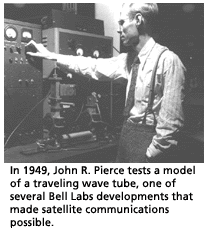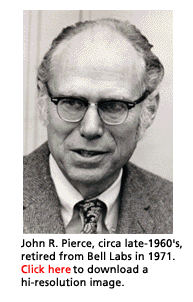|
John
Pierce, Bell Labs Scientist
Man Who Named the Transistor Dies at 92
Copyright © 2002
Lucent Technologies. All rights reserved. *
|

J ohn Pierce, one of the 20th century's
leading engineers and the man behind Telstar, died on
April 2, 2002 in Sunnyvale, Calif. He was 92.
 Pierce had a
35-year career at Bell Labs that gained him an
internationally renowned reputation as a scientist and
engineer. He helped lead early advances in satellite
communications and digital music, but it was for an
informal contribution to a colleague that he might be
best remembered: he was the guy who named the century's
greatest invention - the transistor. Pierce had a
35-year career at Bell Labs that gained him an
internationally renowned reputation as a scientist and
engineer. He helped lead early advances in satellite
communications and digital music, but it was for an
informal contribution to a colleague that he might be
best remembered: he was the guy who named the century's
greatest invention - the transistor.
The revolutionary new switch, invented in Bell Labs in
Murray Hill, N.J., in 1947, soon would replace vacuum
tubes and drive the digital age, turning the world of
electronics, indeed the world itself, upside down and
into a world of miniaturized circuits and boundary-less
communications.
Bill Baker, a colleague of Pierce's, and former Bell
Labs president, felt Pierce's biggest contribution to
Bell Labs was his innate ability to inspire and lead
people.
"In research for the Bell System," Baker once
said, "John Pierce unwaveringly looked for the most
challenging ideas that science and engineering could
contain. He often personally phrased these in forms
which excited the best energies and enthusiasms of whole
generations of collaborators.
"His career was unsurpassed in enabling important
phases of the onset and growth of the 20th century era
of telecommunications, information technology and
computer functions."
Pierce considered his most important achievement to be
his proposals for satellite communications. He first
offered his plan in 1954 (three years before Sputnik) at
a Princeton, N.J. meeting of the Institute of Radio
Engineers.
"My topic was space, so I thought it would be
interesting to make some calculations concerning the
possibility of communications satellites, " Pierce
said in 1971, the year he retired from Bell Labs.
"I was astounded at the way things looked when I
actually made the calculations."
 Satellite communications was only one of Pierce's many
contributions to telephony. He's also noted for a new
way to design and manufacture electron guns, traveling
wave tubes and the helix waveguide transmission system.
Pierce also was known for recording some of the earliest
computer-synthesized music, and was largely responsible
for the first live international TV broadcast in 1962,
through his engineering work on the Telstar I satellite.
Satellite communications was only one of Pierce's many
contributions to telephony. He's also noted for a new
way to design and manufacture electron guns, traveling
wave tubes and the helix waveguide transmission system.
Pierce also was known for recording some of the earliest
computer-synthesized music, and was largely responsible
for the first live international TV broadcast in 1962,
through his engineering work on the Telstar I satellite.
Science fiction fans also knew Pierce as J.J. Coupling,
a pen name he used to write sci-fi short stories,
essays, articles and poems. And his contribution to the
century's greatest invention came about in large part
because of Pierce's way with words. His colleague,
Walter Brattain, one of the three inventors who would
share a Nobel Prize for the transistor, asked Pierce if
he had any thoughts about what to call this new
invention. Combining some of the qualities and features
of the new device, Pierce suggested
"transistor." Brattain immediately latched
onto the name and so did the rest of the world for all
time.
Pierce was proud of his seminal contribution to the
evolving vocabulary of pop culture and science.
"It's the most significant thing that ever happened
to me," he once said.
Pierce joined Bell Labs from the California Institute of
Technology in 1936, bearing a doctorate degree from Cal
Tech to specialize in high frequency electron tubes and
microwave research.
In 1952, he became Bell Labs director of electronics
research. He was named director of research in
electrical communications in 1955; executive director,
research - communications principles division in 1958;
executive director, research communications principles
and communications systems in 1962, and executive
director, research - communications sciences division in
1965. Pierce retired from Bell Labs in 1971, becoming
professor of engineering at Cal Tech, and joined the
faculty at Stanford, in Palo Alto, Calif., in 1983.
Pierce's satellite research with colleague Harold Rosen
would earn him the Draper Prize, one of engineering's
top honors, in 1995. He also was awarded a prestigious
Marconi International Fellowship by Columbia University,
the National Medal of Science and the IEEE Medal of
Honor. He held honorary doctorates from the New Jersey
Institute of Technology, Carnegie Institute of
Technology, Northwestern, Yale, Columbia, the
Polytechnic Institute of Brooklyn and the University of
Nevada.
He is survived by his wife, Brenda, and two children.
|
|
 |
|